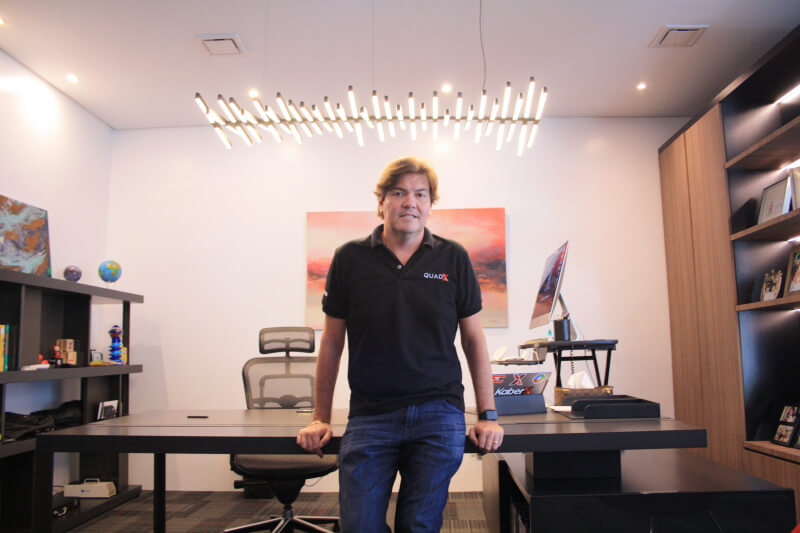Before becoming a founder, Dino Araneta was the president and chief operating officer of LBC Express, one of the largest traditional logistics companies in the Philippines and his family’s business.
Bullish on the prospects of ecommerce, he stepped down in 2014 to start an ecommerce marketplace called TheShop. However, he shut it down as competing against Lazada and Shopee had become tough.
The stint taught him something: Ecommerce sellers face many pain points that are waiting to be addressed. The result was QuadX, a digital logistics company that caters to social commerce sellers in the Philippines.
QuadX founder and CEO Dino Araneta / Photo credit: QuadX
The company is making progress. “We’re going to end the year with over US$30 million [in revenue], pretty much on par” with last year, Araneta tells Tech in Asia.
Those numbers may seem underwhelming in 2020 – what is supposed to be a banner year for ecommerce due to the pandemic.
However, QuadX had lost about four months of cumulative operations this year due to potential and actual Covid-19 infections in its warehouses and among its riders, the founder says. In other words, it would’ve done a lot better if it was at full capacity.
Right now, the company has a blended gross margin of about 28% which can be credited to its asset-light approach of offering services to sellers.
“We never wanted to [just] be a logistics company,” Araneta says. “Our main goal was really to build future-preneurs. We wanted to give everyone a chance to go online and sell their products.”
According to the founder, he’s the only “logistics guy” in the entire startup. The rest of his team is focused on the technology and business side of things.
QuadX, nonetheless, started in the logistics space, which served as a jumping-off point for it to capture the social commerce opportunity in the Philippines.
Logistics with a twist
QuadX offers several services: ShippingCart and Xpost are traditional pick-and-pack operations. XPay is its e-wallet mobile app that serves as a complementary role in its ecosystem.
The company’s flagship product, however, is GoGo Xpress, an online delivery platform for sellers on ecommerce marketplaces and social media.
At face value, GoGo Xpress seems ordinary. Sellers can book deliveries on the platform via a browser or mobile app and a rider will pick up the parcel the next day. Packages are then delivered within one to three days.
But the service crowdsources its entire fleet to support an average of 1.8 million monthly transactions.
“We didn’t set up QuadX to be a traditional logistics player. It was always about crowdsourcing riders and using the new model of crowdsourcing. I thought this would be the best way to scale,” Araneta says.
In essence, Gogo Xpress offers nationwide logistics services just like local logistics firms Ninja Van and J&T Express, but it uses Grab and Gojek’s asset-light model.
QuadX has developed technology to make its model work, spending the past two years creating an address management system (AMS) and a dispatching system to optimize operations.
The AMS was built to navigate the Philippines’ challenging postal code system. Araneta says there are over 40,000 barangays (villages) in the country, but only 10,000 ZIP codes.
To counter that, the company developed its own postal code system on top of its AMS. The system can generate over 100 million different locations across the country and assign each with a “postal code” or “XCode.”
QuadX then set up its Advanced Intelligent Dispatching System, which calculates the most efficient routes and batches orders in a way that incentivizes riders to take jobs.
“Due to our [technology], our riders know a day in advance—or over two days in advance in provinces—how much they will earn when they take a certain order. Can you imagine knowing in advance how much your earnings will be and not just rely on predictive data on whether people will book you as a rider?” Araneta says.
While riders take home a smaller cut from each order they pick up and drop off as compared to Grab or Foodpanda, the dispatching and batching system makes each order more cost-effective and efficient.
The company further claims that the average Gogo Xpress rider earns about 1,200 pesos (US$25) a day, which is 91% over minimum wage and 41% over a regular delivery rider.
Riders are entrepreneurs too
QuadX’s customers include its riders as well, according to Araneta. That said, Gogo Xpress has a strict rating system for them. Those that receive low ratings or hit a certain “failed job percentage” are deactivated for a day or so. On the flip side, good performers get financial bonuses.
The founder claims that because of this system, the level of service Gogo Xpress riders provide is higher than someone with a fixed wage or someone who functions on a per job or per transaction basis.
QuadX operates at a 91% success rate, according to the firm, of which 98.1% of parcels are delivered on time.
The trade-off of a crowdsourcing model, however, is that it may not be able to optimize service quality and costs as well as a player with its own fleet.
Ninja Van, for example, doesn’t believe in employing gig workers.
“We employ someone gainfully for the entire day, someone for whom Ninja Van contributes a majority of earnings,” Ninja Van CEO Chang Wen Lai said in a previous interview.
At current delivery volumes, base load requirements are best served by people who “know they’re well taken care of, are experienced at their job, and tech-enabled,” he added.
To improve service quality, Ninja Van also employs monetary incentives on top of a fixed wage for its delivery people.
Right now, Gogo Xpress has over 6,000 riders on its app, with around 1,600 to 2,000 of them able to deliver an average of 66,000 transactions on a daily basis. It can go up to 3,000 riders a day during peak seasons like the 9.9 or 11.11 sale periods.
In comparison, Ninja Van and J&T Express have about 8,000 and 10,000 riders in the Philippines, respectively.
About 80% of QuadX’s revenue comes from Gogo Xpress shipping fees and 20% from its other services. It hopes to diversify its income more next year.
Delivering for social media sellers
QuadX has big plans of going into social commerce fulfillment and rolling out new modules for GoGo Xpress in 2021, Araneta reveals to Tech in Asia.
While social sellers only contribute 8% of Gogo Xpress’s revenue (as compared to the ecommerce platforms that contribute the rest), the founder sees potential in tapping into this audience.
Based on the company’s research, the Philippine’s social commerce market size in 2019 in terms of gross merchandise volume was at US$1.2 billion and is projected to grow 32% by 2025. As of 2019, social commerce users in the country stood at 11 million.
The goal is to cover all the bases for social sellers in the Philippines to optimize their sales. Some of these modules include inventory management, a customer relationship management tool, and order and checkout pages that are embeddable and shareable. These modules are built on top of Gogo Xpress and will be offered for a monthly fee.
It’s going to be challenging, Araneta acknowledges, to get people to pay for a service that was previously free. So the founder plans on selling these bundles at affordable price points—0r for “half the price of what others would offer.”
Since its inception, the company has been sustained by investments from Araneta’s family. However, it’s now in the midst of raising its first round of funding from investors around Southeast Asia to realize its new plans of expanding across the region and investing in another sorting facility.
But Gogo Xpress faces fierce competition in both the digital logistics and ecommerce enablement spheres.
On the logistics side, Gogo Xpress is up against the likes of GrabExpress and Lalamove, both of which cater to social sellers. But Araneta thinks his firm stacks up well against them on price.
“We haven’t done same-day delivery yet, but once we do, our price offer will also be half the price of what everyone does,” he says. “It’s not a per-kilometer charge, it’s a flat fee.” QuadX claims to be able to do this thanks to the technology Araneta has described.
On the ecommerce enabler side, Thailand-based aCommerce is a strong, well-funded, and established player across Southeast Asia.
That said, Araneta believes QuadX is unique in how it “crowdsources its last-mile and first-mile riders.”
Keeping up amid a pandemic
QuadX has experienced a 72% compound annual growth rate from 2016 until present, though the company’s growth was flat from 2018 to 2019, as it was developing its technologies.
2020 was supposed to be a year of growth for QuadX because it would have been able to fully tap into its technologies to optimize revenue. But like other firms, the pandemic threw a wrench in its plans.
In spite of this setback, the behavioral changes brought about by the pandemic has caused a spike in its orders.
Order numbers grew by up to 40% for both ShippingCart and Gogo Xpress since lockdowns started in March. QuadX, however, had to reject orders because its capacity was affected by Covid-19 and it couldn’t handle all the new orders coming in.
While the company hasn’t achieved break-even point yet, it hopes that the rollout of its new Gogo Xpress modules will help it get to the promised land.








